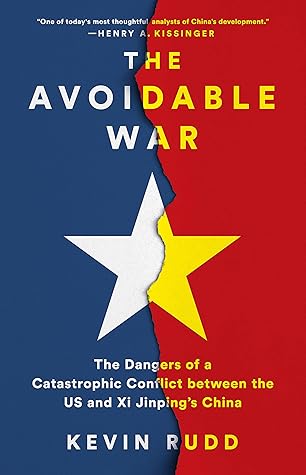More on this book
Community
Kindle Notes & Highlights
by
Kevin Rudd
Read between
February 3 - February 6, 2023
These include enhancing economic exchange with Europe and the Middle East, securing a more benign strategic environment for China itself, and stabilizing Islamic central and South Asia—and all this across a vast continental landmass less susceptible to American strategic influence than maritime East Asia. China also hopes to build up new markets to help mitigate the consequences of being excluded from future economic opportunities in the United States and its closest allies.
So while the BRI may be attacked as a gargantuan, ill-coordinated, multi-trillion-dollar Chinese geopolitical project, the cold hard reality is that the only counterprogram launched by the US during the Trump years was a single $100 billion loan program called the Build Act. The BRI, by contrast, had by 2021 funded some 2,600 projects across one hundred countries at a cost of $3.7 trillion.
always preferring to be the friend of all and the enemy of none—a strategically adept, albeit ethically neutral, position. However, geopolitical reality will not allow such strategic ambiguity for much longer.
Trump, as on so many other things, was wrong.
Finally, the top military intelligence official at US Indo-Pacific Command, two-star Rear Admiral Michael Studeman, made an unannounced visit to Taiwan in November.
In the bloody history of the CCP, rectification campaigns certainly focus the mind. And Xi Jinping plays for keeps. However, it is important to understand that the reason Xi continues to resort to these harsh measures is because he is acutely aware that the radical changes he has brought about in China’s overall political and policy direction have earned him a powerful group of enemies.
Xi’s real political vulnerability lies with the economy. As noted in previous chapters, the economy is not his policy strong suit.
Therefore, his recent major adjustments to China’s domestic economic growth model outlined in chapter 6, including the reemphasis of the state over the market, and his new restrictions on the Chinese private sector pose a real political danger to his leadership if growth, employment, or living standards were to stall. This, in my judgment, is Xi’s greatest liability, particularly given that his critics in the party leadership elite have previously championed a different economic policy strategy for China’s future.
That is not to say that Xi Jinping Thought is devoid of substantive content. But it is largely limited to three core propositions: (1) Chinese ideological orthodoxy is to be an amalgam of Marxism-Leninism, Chinese tradition, and Chinese nationalism—with the precise weighting of the amalgam to be defined by the party leadership from time to time depending on the need. (2) This orthodoxy embraces the current move toward the left on politics and the economy and to the right on nationalism. (3) Beyond intellectual cognition and moral legitimization, this new ideology legitimizes struggle as a
...more
gray rhino events,
Comparatively, China’s economy does not yet come close to measuring up against the economies of other advanced countries. China’s economy is still only 30 percent as productive as the US, Japanese, or German economies. Most economists’ evaluation of the reasons for this is clear: the continued size, influence, and unproductive investment of the state sector.
In the Chinese nationalist take, all of these are indicative of the overall decline of the West, which is China’s accepted political code language to refer to the decline of the United States.
The trick in this case is to reduce these risks as competition intensifies by jointly crafting a limited number of rules of the road that can help prevent war.
But the strategic rationale for each of these three sets of agendas is the same: it is better for both countries to operate within a joint framework of managed competition than to have unmanaged competition with no rules at all.
managed strategic competition
History tends not to believe in limited wars. Instead, history tells us that wars are far more likely to escalate out of control. By contrast, kicking the can down the road creates political space—space that over time can accommodate changing diplomatic sentiment that, in turn, may be capable of bringing about a long-term, peaceful resolution to the all-encompassing strategic competition currently engulfing these two great powers of the twenty-first century.
This approach is far from perfect. But for those who disagree with it, I repeat my challenge: the responsibility lies with critics to come up with a credible alternative. It is easy to come up with unilateral options for the future—that is, advice to either side on how they might militarily prevail against the other. But it is much harder to think through a joint framework for the future that preserves the peace without undermining each other’s fundamental national interests. The reality is that in this new age of strategic competition between China and the United States, there are, as a
...more
I doubt that many of the armchair strategists commenting on the coming conflict between China and the United States have thought through how many Chinese, American, and Taiwanese service members and civilians would be killed. They may not have imagined the extent to which the Chinese Communist Party would see itself as fighting for its very survival in such a war or understood how a conventional war could thus easily escalate into one involving weapons of mass destruction if Chinese forces began to lose. These are the sort of real-world considerations that should inform public debate in both
...more
a mutually agreed strategic framework for avoiding war while preserving a principled peace, and one that would need to be robust enough to provide clear-cut strategic guidance for both the political and military leadership of each country for the decade ahead. At the same time, it would need to be sufficiently flexible to deal with multiple contingencies as they arose. This is the essential strategic rationale for the concept of managed strategic competition.


